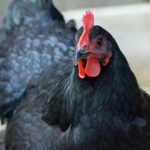All educational & Resource Articles Are Submitted By Volunteers
Orpington chickens are a versatile chicken breed developed in Kent, England around the late 1800s. It was specifically bred to be useful in both egg production and meat quality. While there are many varieties of Orpingtons, they all share some key characteristics: large bodies with long, broad feathers that make them look almost round.
Orpington chickens are known for their docile and calm temperament, making them an excellent choice for first-time flock owners! These birds are highly cold-hardy and often continue laying eggs through frigid winters and shorter days. Their large size and thick feathering help keep them warm and cozy during cold weather. While well-suited for cold climates, Orpingtons can also tolerate heat if provided with several shady spots during the hottest parts of the day. In addition to their egg-laying abilities, Orpingtons are also valued for their meat, making them a versatile and dependable dual-purpose breed.
Quick Breed Facts
- Alternative name(s): None
- Hen (female) weight: 5-6lbs
- Rooster (male) weight: 6-7lbs
- Eggs per-week: 4-5
- Egg productivity: Excellent
- Egg color: Light brown
- Egg size: Large
- Category / purpose / use: Eggs, meat & show
- Temperament: Friendly, noisy, docile, calm, laid-back
- Broodiness: Yes & they make excellent mothers
- Comb type: Single
- Rarity: Common
- Feathered legs: No
- Breed size: Standard
- Climate tolerance: Colder climates
- Foraging (free-ranging) ability: Excellent
- Hybrid: No
- Skin color: White / pink
- Other color varieties: Buff, white, black, splash, Jubilee, chocolate, red, isabel, partridge, cuckoo, lavender, lemon cuckoo, blue cuckoo, chocolate cuckoo, silver-laced, gold-laced
- Recognized in the American Poultry Association?: Yes, depending on the color variety.
- Country of origin: Kent, United Kingdom
Frequently Asked Questions
Is this breed a good beginner-type breed?: Orpington chickens are a hardy and beginner-friendly breed, making them an excellent choice for those new to raising chickens. While they are known for their occasional loud and chatty behavior, which may not be ideal for suburban or urban settings, their docile, calm, and friendly nature makes them perfect pets—especially for families with children. Young hens (pullets) typically start laying eggs around 18 to 22 weeks of age, producing large, light brown eggs consistently. This versatile breed is a fantastic all-around option for anyone looking to start their own flock!
Can this breed do well in a confinement-like setting?: Yes, Orpingtons can thrive in a confined space as long as they have adequate room to get away from potential bullies within the flock. Since they are not typically a dominant breed in the pecking order, they may be more susceptible to being bullied by older or more assertive flock members. Orpingtons are generally a more laid-back and less active breed, making confinement a suitable environment for them. Orpingtons are also excellent foragers, consistently searching for insects and scratching the ground for grubs to eat.
Is this breed predisposed or prone to any health conditions, concerns or disease?: It is important to note that there may be some challenges associated with raising any sort of rare breed or color variety of the breed and many chicken owners find it to be a rewarding experience to help preserve and protect these unique chicken breeds or color varieties within the breed. As with any rare color variation of the Orpington breed, they may have a smaller gene pool, which can lead to increased sensitivity and fragility as chicks and incubation. Orpington chickens are prone to a variety of health concerns, however it is mainly caused by their diet. Orpingtons are prone to obesity, which can lead to potential heart disease or failure, fatty liver disease and since being bred strictly for egg production, this breed has an increased risk of becoming egg bound and other reproductive conditions.
- Buff – The buff color variety is the most common among the Orpington breed. This variation is also the most developed in terms of egg-laying and meat production. Additionally, buff Orpingtons are known for being the most docile and friendly of all the color variations within the breed.
- Lavender – The lavender color variety is the second most common among Orpingtons. Not only is its soft gray-blue plumage pleasing to the eye, but this variety is also fairly well-developed for both egg production and meat quality!
- Blue/Black/Splash – All the color variations within the Orpington breed share the same genetic foundation, making them quite similar in temperament and characteristics despite their different appearances. In poultry, the “blue” color doesn’t breed true without the presence of either the black or splash gene. While the blue/black/splash (BBS) variation is harder to find in Orpingtons, all three color variations are stunning and highly sought after!
- White – Although a simple color variation, this type of Orpington is primarily favored by poultry farmers for its excellent egg production and meat quality.
- Red – The red color variation of Orpingtons is relatively rare and not as popular in the poultry world, possibly due to other breeds and color varieties overshadowing it. However, red Orpingtons are excellent for both egg production and meat, making them a great addition to anyone’s flock!
- Chocolate – The chocolate color variety is a relatively new addition to the Orpington breed and has quickly gained popularity among poultry enthusiasts. However, raising these chicks can be challenging due to the smaller gene pool associated with this color. Breeders are actively working to improve the sustainability and strength of this color variation of Orpingtons.
- Partridge – The partridge color variety of Orpingtons is not as widely popular and can be difficult to find. It features a well-defined, unique brown pattern. There are few breeders focusing on this coloration, as it is often overshadowed by other breeds that share the same color variety and is not in high demand.
- Silver & Gold Laced – Despite their different colors, both of these Orpington color variations share the same beautiful lacing. While they are quite rare in the United States, they are very popular in Europe. These color varieties are gaining traction in the U.S., but there are still limited breeders and a small gene pool, making them a challenge to raise as chicks.
- Isabel – The Isabel color variety is a rare and challenging Orpington color to find and raise. As a newer variation, it has slowly gained popularity among poultry enthusiasts and breeders. Due to its limited gene pool and the fact that the Isabel color doesn’t always breed true, this variety can be quite pricey. Raising Isabel chicks can be difficult, as their appearance may not always match the shiny, pearl-like color seen in photos, due to the unpredictable makeup of their coloration.
- Cuckoo/Lemon Cuckoo – The Cuckoo color variety of Orpington is another rare and challenging color to find and raise in the United States. While the Cuckoo coloration itself isn’t new, the sub-colorations of the Cuckoo gene, including lemon, blue, and chocolate, are. With a limited number of breeders in the US specializing in these color varieties, they can be quite pricey.
- Jubilee – The Jubilee color variety of Orpingtons first arrived in the United States in the early 1990s and has quickly gained popularity due to its strikingly beautiful color pattern. However, there are not enough breeders to meet the high demand for this color variation, making this color variety pricey. Jubilee Orpingtons are known for being docile, laid-back and make excellent dual-purpose birds, suitable for both egg production and meat.
How does this breed handle different climates & temperatures?: Orpington chickens are a hardy breed that can thrive in various climates. However, they are more sensitive to extreme hot temperatures due to their thick feathering, it makes it difficult for this breed to keep cool in the heat. Provide plenty of shady spots and fresh cool water in high temperatures.

The Pros & Cons of Orpington Chickens
The pros:
- They make a wonderful beginner breed of chicken for newbie chicken owners!
- Can tolerate confinement very well.
- Orpington hens tend to go broody and make wonderful mothers to their chicks.
- They make an excellent dual-purpose breed for egg production and meat.
- Orpington chickens are a much more lazier breed, making them calm, laid-back and not as dominate in the pecking order.
- They are an excellent source of laying large light brown eggs!
- Wonderful foragers, performing great with a free-range setting.
- Orpington chickens would make an amazing poultry exhibitioner-type breed of chicken for anyone wanting or looking to show birds!
- Roosters of this breed are a lot more tolerant of each other and are less likely to fight as long as there is enough room to get away.
The cons:
- Orpington chickens can be noisy, making them not the best breed of chicken for those who live in the suburbs/city.
- Since Orpington chickens have thick down feathers, they don’t handle extreme high temperatures very well.
- Orpington chickens are prone to health issues related to their diet, particularly obesity. This can lead to several serious conditions, including heart disease, fatty liver disease and an increased risk of heart attacks. Proper diet and exercise are essential to help prevent these health problems.
- Since this breed was bred strictly for egg production, Orpington chickens have an increased risk of becoming egg-bound (egg binding / egg that is stuck inside), Salpingitis (lash egg infection caused by the Staph bacteria) possibly developing reproductive cancer.
Are Orpington chickens the right breed of chicken for you?
Yes— the Orpington chicken breed is good for you or your flock if you..
- Want an excellent egg layer of light-brown-colored eggs.
- A breed of chicken that can perform well and is tolerant of all climates.
- Want a breed that’s hardy and easy to raise.
- Want a good broody hen that raises her chicks well.
- Are looking for a breed of chicken that are wonderful foragers and performs very well in a free-ranging setting.
- A breed of chicken that can be confined.
- Want a breed of chicken that can be used in poultry shows / exhibitions.
Photos/pictures provided by Google
If you own any of the photos above and wish to have them removed, please email the rescue’s email.
Andalusian Andalusian Chicken Chicken Chicken breeds Chickens
Last modified: December 8, 2024










